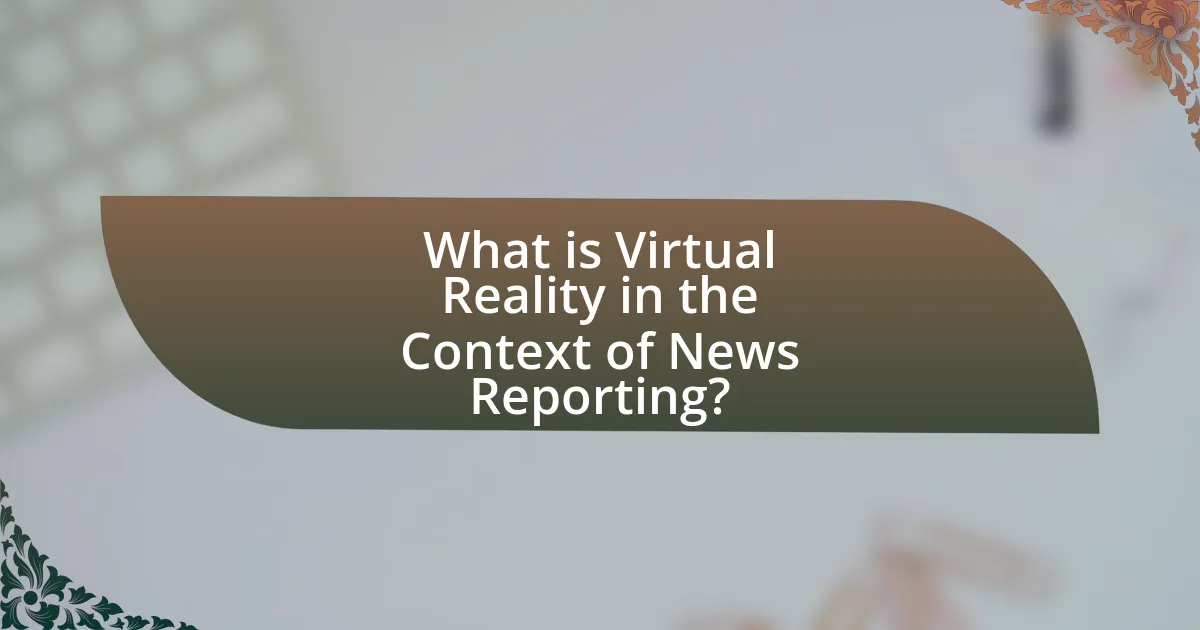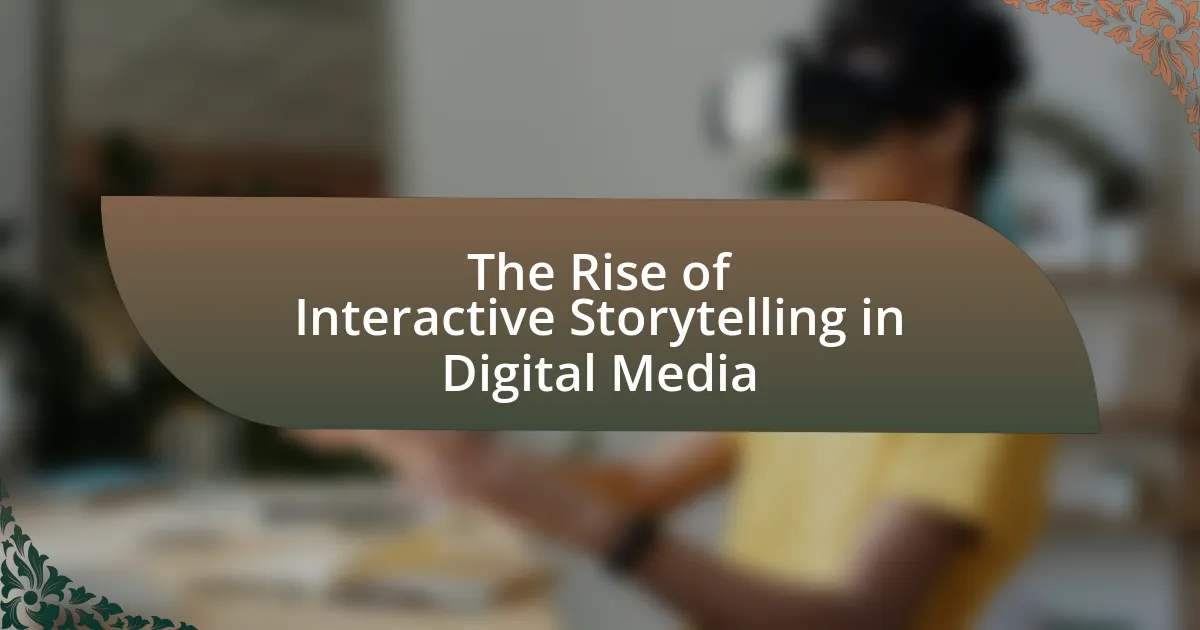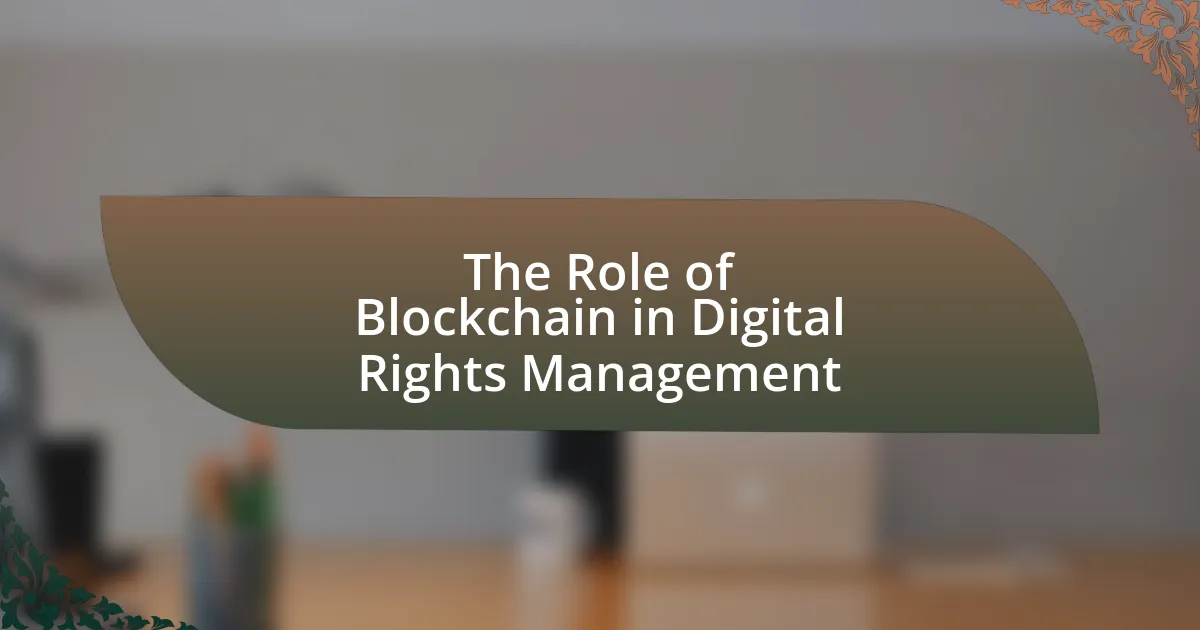Virtual Reality (VR) is revolutionizing news reporting by providing immersive, interactive experiences that enhance audience engagement and emotional connection to news stories. This article explores how VR allows viewers to experience events in a three-dimensional environment, fostering empathy and improving information retention. Key technologies involved in creating VR news content, such as 360-degree cameras and VR headsets, are discussed, along with the benefits and challenges of implementing VR in journalism. Additionally, the article examines audience responses to VR news experiences and the future trends of VR in news reporting, highlighting the potential of artificial intelligence and advancements in technology to further enhance this medium.

What is Virtual Reality in the Context of News Reporting?
Virtual Reality (VR) in the context of news reporting is an immersive technology that allows audiences to experience news stories in a three-dimensional environment. This technology enables viewers to engage with news content interactively, providing a sense of presence and emotional connection to the events being reported. For instance, VR can transport users to the scene of a natural disaster or a conflict zone, enhancing their understanding of the situation through a first-person perspective. Studies have shown that immersive experiences can lead to greater empathy and retention of information, making VR a powerful tool for storytelling in journalism.
How does Virtual Reality enhance the news reporting experience?
Virtual Reality enhances the news reporting experience by immersing viewers in a 360-degree environment that allows them to experience news events as if they were physically present. This immersive experience fosters a deeper emotional connection to the story, making complex issues more relatable and engaging. For instance, a study by the University of Southern California found that VR can increase empathy in viewers, as they can witness events from the perspective of those directly affected. This capability transforms traditional news consumption into an interactive experience, thereby increasing viewer retention and understanding of critical issues.
What technologies are involved in creating Virtual Reality news content?
Creating Virtual Reality news content involves several key technologies, including 360-degree cameras, VR headsets, and software for content creation and editing. 360-degree cameras capture immersive video footage that allows viewers to experience news stories from multiple angles, enhancing engagement. VR headsets, such as the Oculus Rift or HTC Vive, provide the necessary hardware for users to experience the content in a fully immersive environment. Additionally, software tools like Unity or Unreal Engine are utilized for developing and editing VR experiences, enabling creators to integrate interactive elements and storytelling techniques that are unique to the medium. These technologies collectively transform traditional news reporting into an interactive and immersive experience, making it more impactful for audiences.
How does user immersion impact the perception of news stories?
User immersion significantly enhances the perception of news stories by creating a more engaging and emotionally resonant experience for the audience. When users are immersed in a virtual reality environment, they are more likely to feel present in the story, which can lead to increased empathy and understanding of the issues being reported. Research conducted by the University of Southern California found that participants who experienced news stories in virtual reality reported higher emotional engagement and a greater likelihood of sharing the content compared to traditional media formats. This heightened emotional connection can influence viewers’ attitudes and perceptions, making them more receptive to the information presented.
What are the key benefits of using Virtual Reality in news reporting?
The key benefits of using Virtual Reality in news reporting include enhanced audience engagement, immersive storytelling, and improved emotional connection. Enhanced audience engagement occurs as VR allows viewers to experience news events in a 360-degree environment, making them feel present at the scene. Immersive storytelling is achieved through the ability to present complex narratives in a more interactive format, which can lead to better understanding and retention of information. Improved emotional connection is facilitated by VR’s capacity to evoke empathy, as users can witness events from the perspective of those affected, leading to a deeper emotional response. Studies have shown that immersive experiences can increase viewer retention rates by up to 70%, demonstrating the effectiveness of VR in capturing audience attention and fostering a more profound connection to the news.
How does Virtual Reality improve audience engagement?
Virtual Reality (VR) improves audience engagement by creating immersive experiences that allow users to interact with content in a more meaningful way. This heightened level of interactivity fosters emotional connections and enhances retention of information. Research indicates that VR can increase engagement levels by up to 30% compared to traditional media formats, as users feel more present and involved in the narrative. For instance, a study by the Stanford Virtual Human Interaction Lab found that participants who experienced news stories in VR reported a stronger emotional response and a greater understanding of the content, demonstrating VR’s effectiveness in enhancing audience engagement in news reporting.
What unique storytelling opportunities does Virtual Reality provide?
Virtual Reality (VR) provides unique storytelling opportunities by immersing users in a 360-degree environment, allowing them to experience narratives from a first-person perspective. This immersive experience enhances emotional engagement, as users can interact with the story and its characters, creating a sense of presence that traditional media cannot achieve. For instance, a study by the University of Southern California found that VR can increase empathy in users, as they feel as though they are part of the story rather than mere observers. Additionally, VR enables the exploration of complex topics, such as social issues or historical events, in a way that allows users to gain a deeper understanding through experiential learning.

How is Virtual Reality being implemented in news organizations?
Virtual Reality (VR) is being implemented in news organizations to enhance storytelling and audience engagement. News outlets like The New York Times and BBC have developed immersive VR experiences that allow users to experience news events from a first-person perspective, such as walking through war zones or exploring natural disasters. For instance, The New York Times launched a VR app that provides users with 360-degree videos of significant news stories, thereby increasing emotional connection and understanding of complex issues. This implementation of VR in journalism not only enriches the narrative but also attracts a tech-savvy audience, as evidenced by the growing number of users engaging with VR content in news media.
What are some examples of news outlets using Virtual Reality?
Several news outlets are utilizing Virtual Reality to enhance storytelling and engage audiences. Notable examples include The New York Times, which launched a VR app called NYT VR, allowing users to experience immersive news stories. BBC has also embraced VR, producing content like “The Turning Forest,” which offers a unique perspective on environmental issues. Additionally, CNN has developed VR experiences for major events, such as the 2016 election, providing viewers with an immersive way to engage with news coverage. These outlets demonstrate the growing trend of integrating Virtual Reality into journalism to create more impactful narratives.
How have specific news stories been transformed through Virtual Reality?
Specific news stories have been transformed through Virtual Reality by providing immersive experiences that allow audiences to engage with events in a more impactful way. For instance, news organizations like The New York Times have utilized VR to transport viewers to locations such as war zones or natural disaster sites, enabling them to experience the environment and context of the stories firsthand. This approach enhances emotional connection and understanding, as evidenced by the increased viewer retention and engagement metrics reported by media outlets that have adopted VR storytelling techniques.
What challenges do news organizations face when adopting Virtual Reality?
News organizations face significant challenges when adopting Virtual Reality, primarily including high production costs, technical expertise requirements, and audience accessibility issues. High production costs arise from the need for specialized equipment and software, which can strain budgets, especially for smaller organizations. Technical expertise is crucial, as creating immersive VR content requires skilled personnel who understand both storytelling and technology, which may not be readily available. Additionally, audience accessibility poses a challenge, as not all consumers have access to VR headsets or the necessary technology to experience VR content, limiting the potential reach of such innovations. These factors collectively hinder the widespread adoption of Virtual Reality in news reporting.
How do audiences respond to Virtual Reality news experiences?
Audiences respond positively to Virtual Reality (VR) news experiences, often reporting heightened engagement and emotional connection to the content. Research indicates that VR can create a sense of presence, making viewers feel as though they are part of the story, which enhances their understanding and retention of information. A study by the University of Southern California found that participants who experienced news in VR reported a stronger emotional response compared to traditional media formats, with 70% expressing a greater sense of empathy towards the subjects of the news stories. This immersive quality of VR news experiences leads to more impactful storytelling and a deeper connection with the audience.
What demographic factors influence the acceptance of Virtual Reality news?
Age, gender, education level, and technological familiarity are key demographic factors influencing the acceptance of Virtual Reality (VR) news. Research indicates that younger individuals, particularly those aged 18-34, are more likely to embrace VR news due to their higher comfort with technology and immersive experiences. Gender differences also play a role, with studies showing that males tend to engage more with VR content than females. Additionally, individuals with higher education levels are more inclined to accept VR news, as they often have greater exposure to advanced technologies and innovative media formats. Familiarity with technology significantly impacts acceptance; those who regularly use VR or similar technologies are more open to experiencing news in this format. These insights are supported by findings from the Pew Research Center, which highlight the correlation between demographic characteristics and media consumption preferences.
How does audience feedback shape the future of Virtual Reality in news reporting?
Audience feedback significantly shapes the future of Virtual Reality in news reporting by guiding content creation and enhancing user engagement. As news organizations analyze audience reactions and preferences, they can tailor VR experiences to meet viewer expectations, leading to more immersive and relevant storytelling. For instance, a study by the Pew Research Center found that 70% of users prefer interactive content, indicating that audience input directly influences the design and functionality of VR news applications. This iterative process ensures that news reporting evolves to incorporate features that resonate with viewers, ultimately improving the effectiveness of VR as a medium for delivering news.

What are the future trends of Virtual Reality in news reporting?
The future trends of Virtual Reality in news reporting include immersive storytelling, enhanced audience engagement, and real-time reporting capabilities. Immersive storytelling allows viewers to experience news events as if they were present, fostering a deeper emotional connection to the content. Enhanced audience engagement is achieved through interactive VR experiences that enable users to explore news stories from multiple perspectives. Real-time reporting capabilities will be bolstered by advancements in VR technology, allowing journalists to deliver live updates from the scene, thereby increasing the immediacy and relevance of news coverage. These trends are supported by the growing adoption of VR technology in media, with companies like The New York Times and BBC investing in VR content to enhance their reporting.
How might advancements in technology influence Virtual Reality news reporting?
Advancements in technology significantly enhance Virtual Reality (VR) news reporting by improving immersion, interactivity, and accessibility. Enhanced graphics and processing power allow for more realistic environments, making news stories more engaging and impactful. For instance, the integration of 5G technology facilitates faster data transmission, enabling real-time VR experiences that can transport viewers to the scene of breaking news events. Additionally, developments in haptic feedback technology provide users with tactile sensations, further immersing them in the news narrative. Research from the University of Southern California indicates that immersive storytelling in VR can increase viewer retention and emotional engagement, demonstrating the effectiveness of these technological advancements in transforming news reporting.
What role will artificial intelligence play in enhancing Virtual Reality news experiences?
Artificial intelligence will significantly enhance Virtual Reality news experiences by personalizing content delivery and improving user engagement. AI algorithms can analyze user preferences and behaviors to curate tailored news experiences, ensuring that viewers receive relevant information in an immersive format. For instance, a study by the Pew Research Center indicates that personalized content increases viewer retention by up to 50%. Additionally, AI can facilitate real-time data analysis, enabling journalists to present live updates and interactive elements within VR environments, thus enriching the storytelling experience.
How can Virtual Reality evolve to meet changing audience expectations?
Virtual Reality can evolve to meet changing audience expectations by enhancing interactivity, improving realism, and personalizing experiences. As audiences increasingly seek immersive and engaging content, VR technology must integrate advanced features such as haptic feedback, real-time user interaction, and adaptive storytelling. For instance, a study by PwC found that 78% of consumers are interested in VR experiences that allow them to interact with content in a meaningful way. Additionally, incorporating AI-driven personalization can tailor experiences to individual preferences, making VR more relevant and appealing. This evolution aligns with the growing demand for innovative storytelling methods in news reporting, as audiences expect more than passive consumption of information.
What best practices should news organizations follow when implementing Virtual Reality?
News organizations should prioritize user experience, storytelling, and ethical considerations when implementing Virtual Reality. Focusing on user experience ensures that the VR content is accessible and engaging, which can enhance audience retention and understanding. Effective storytelling in VR requires a clear narrative structure that guides users through the experience, making it immersive and impactful. Additionally, ethical considerations, such as respecting privacy and avoiding sensationalism, are crucial to maintain credibility and trust with the audience. These best practices are supported by industry insights, such as the 2020 report from the Pew Research Center, which highlights the importance of immersive storytelling in enhancing viewer engagement in news media.
How can news organizations ensure ethical standards in Virtual Reality reporting?
News organizations can ensure ethical standards in Virtual Reality reporting by implementing strict guidelines that prioritize accuracy, consent, and representation. These organizations should establish protocols for verifying information before it is presented in VR, ensuring that the content is factually correct and not misleading. Additionally, obtaining informed consent from individuals featured in VR experiences is crucial, as it respects their autonomy and privacy rights. Furthermore, news organizations must strive for diverse representation in their VR narratives to avoid perpetuating stereotypes and to provide a more comprehensive view of the stories being told. Research indicates that ethical frameworks, such as those proposed by the Society of Professional Journalists, emphasize the importance of these principles in maintaining public trust and credibility in journalism.
What strategies can enhance the effectiveness of Virtual Reality news content?
To enhance the effectiveness of Virtual Reality (VR) news content, employing immersive storytelling techniques is crucial. Immersive storytelling allows viewers to engage with the news on a deeper emotional level, making the experience more impactful. For instance, using 360-degree video can place viewers in the center of the action, fostering a sense of presence that traditional media cannot achieve. Research indicates that immersive experiences can increase information retention by up to 70%, as users are more likely to remember content that they actively engage with rather than passively consume. Additionally, integrating interactive elements, such as allowing users to choose their perspective or explore different aspects of a story, can further enhance engagement and understanding. These strategies collectively contribute to a more compelling and effective VR news experience.




